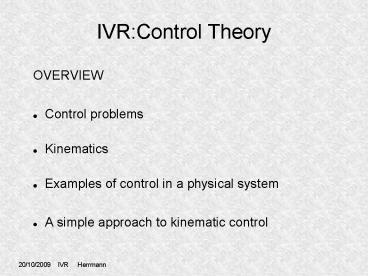IVR:Control Theory - PowerPoint PPT Presentation
Title: IVR:Control Theory
1
IVRControl Theory
- OVERVIEW
- Control problems
- Kinematics
- Examples of control in a physical system
- A simple approach to kinematic control
2
The control problem
Outcome
Action
Goal
Motor command
Robot in environment
- For given motor commands, what is the outcome?
? Forward model - For a desired outcome, what are the motor
commands? ? Inverse model - From observing the outcome, how should we adjust
the motor commands to achieve a goal?
? Feedback control
3
The control problem
command voltage torque
force angle position
camera
- Forward kinematics is not trivial but usually
possible - Forward dynamics is hard and at best will be
approximate - But what we actually need is backwards kinematics
and dynamics -
Difficult!
4
Inverse model
- Find motor command given desired outcome
- Solution might not exist
- Non-linearity of the forward transform
- Ill-posed problems in redundant systems
- Robustness, stability, efficiency, ...
- Partial solution and their composition
5
Problem Non-linearity
- In general, we have good formal methods for
linear systems - ReminderLinear function
- In general, most robot systems are non-linear
F(x)
x
6
Kinematic (motion) models
Example A simple arm model
- Differentiating the geometric model provides a
motion model (hence sometimes these terms are
used interchangeably) - This may sometimes be a method for obtaining
linearity (i.e. by looking at position change in
the limit of very small changes)
7
Differential Equations
Using known relations between quantities and
their rate of change in order to find out how
these quantities change
- Mathematics Equation that is to be solved for
an unknown function - PhysicsDescription of processes in nature
- EngineeringRealizability of a goal by a plant
by including control terms - Informatics Tool for realistic modeling
8
Differential Equations
fast growth starting from initial value x(t0)x0
decay with time scale -1/at
9
Dynamic models
- Kinematic models neglect forces motor torques,
inertia, friction, gravity - To control a system, we need to understand the
continuous process - Now An Example for control of a physically
realistic model - Next A simple example of control
10
Dynamic models
- Kinematic models neglect forces motor torques,
inertia, friction, gravity - To control a system, we need to understand the
continuous process - Start with simple linear example
11
Example Electric motor
- Ohms law Kirchhoff's law
- Motor generates voltage
- proportional to speed
- Vehicle acceleration
- (M is a motor constant)
- Torque t is proportional to current
- Putting together
12
General form
- VB Control variable input
- s State variable output
- ABd/dt Process dynamics
- Dynamics determines the process, given an initial
state s(t0)s0. - State variable s(t) separates past and future
- Continuous process models are often differential
equations!
13
Process Characteristics
- Given the process, how to describe the behaviour?
- Concise, complete,
implicit, obscure
- Characteristics
- Steady-state What happens if we wait for the
system to settle, given a fixed input? - Transient behaviour What happens if we suddenly
change the input? - Frequency response What if we smoothly/regularly
change the inputs?
14
Control theory
- Control theory provides tools
- Steady-state ds/dt 0,
- Transient behaviour (e.g. change in voltage from
0 to 7V) exponential decay
towards steady state - Half-life of decay
(Solve for
using )
15
(No Transcript)
16
Example
- Suppose
M vehicle mass
R setti
ng - If robot starts at rest, and apply 7 volts
- Steady state speed
- Half-life
- Time taken to cover half the gap between current
and steady-state speed
17
Motor with gears
Battery voltage VB
Gear ratio g where more gear-teeth near output
means g gt 1
?
smotor
sout
smotor g sout for g gt 1, output velocity is
slower torquemotor g -1 torqueout for g gt 1,
output torque is higher
Thus Same form, different steady-state,
time-constant etc.
18
Motor with gears
- Steady-state
- Half-life
- i.e. for ? gt 1, reach lower speed in faster time,
robot is more responsive, though slower. - N.B. we have modified the dynamics by altering
the robot morphology.
19
Electric Motor Over Time
- Simple dynamic example
- We have a process model
- Solve to get forward model
- Derivation of this andmore general cases using
e.g. Laplace transformation
20
A fairly simple control algorithm
21
A Simple Controller
System
System Controller
a simple choice for the controller
a simple choice for prediction xpred
xold
What if there is no analytical description of the
system? Stabilizing controller for box pushing
or wall-following more complex behaviors for
more complex predictors
22
A Simple Controller
How to find better parameters ci in K S ci xi
?
cexpl c a sin(w t)
?c lt E(t) sin (w t) gt
short-term average
Perform test actions at both sides of the
trajectory works best in 1D (e.g. for steering)
23
Summary
- Forward and inverse models
- Calculating control is hard but not impossible
for many control problems - Controlling by probing
- Feed back control (next time)
24
Beyond Inverse Models
- Feed-back control
- Dynamical systems
- Adaptive control
- Learning control
1788 by James Watt following a suggestion from
Matthew Boulton































